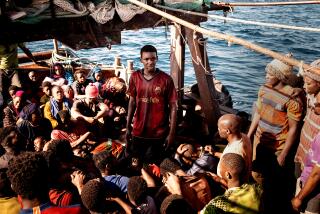They Never Played It, Sam : Film Failed to Reflect the Real Casablanca
- Share via
CASABLANCA, Morocco — American visitors to this Moroccan city often ask for Rick’s Cafe.
But there isn’t any Rick’s Cafe, not even one without ceiling fans and bead curtains. Never was one either, except in the 1942 movie “Casablanca.”
In fact, Moroccans who have seen the Warner Brothers classic cannot recognize the celluloid city nor any of the scenes or characters.
“It’s entertaining if a bit mystifying,” said Larbi Ben Ahmed, an English-language student. “My guess is the people who made it never came here.”
Kilroy was here, when the U.S. Air Force ran a big base outside the city until 1963. But there is no record of the movie’s stars--Humphrey Bogart, Ingrid Bergman, Peter Lorre or Sidney Greenstreet--visiting the real city.
Most of the 2 million Casablancans have never heard of Rick, and “Play it, Sam” means nothing to them.
Usually only foreigners get the message when they see the blow-up of Bogart in the bar of the Hyatt Regency Hotel on the city’s main square.
Native Casablancans express irritation when U.S. reporters liken hotbeds of drug dealing, intrigue and corruption to Casablanca. They do not see their city as a Hollywood myth of a criminal derring-do and commercial skulduggery.
“This is Casablanca, not Chicago, certainly not Miami,” travel agent Ahmed Belghiti said. “The only thing we have in common with Florida is that we are on the same altitude. We have the same sun too.”
“Gee, it’s just like home, with turbans,” Gene Hopkirk of Houston said after touring the parks, spacious squares and boulevards lined with glass-fronted high rises.
Hopkirk said he also saw sordid shantytowns packed with poor peasants. “Somehow poverty does not seem so bad in the sunshine,” he said. “Like I said, it’s just like home.”
Like most big cities, Casablanca has its sleazy side. But tourists enjoy good restaurants and a relaxed, hospitable atmosphere amid graceful Moorish architecture and mosques. The Atlantic port city gets its name from its sunlit white buildings-- casa blanca, Spanish for white house.
A much-traveled Middle East visitor said it was one of the cleanest cities in the Arab world.
As for being a “hotbed of drug dealing,” police admit that some people can be found reclining on cool couches smoking marijuana while sipping the fragrant local mint tea.
“Keef,” the marijuana grown in Morocco for centuries, is just a bit more expensive than the local black-tobacco cigarettes called Casa Sports, which to most foreigners are a pretty fierce smoke.
But officials say that big-time trafficking of hard drugs doesn’t exist here. The only serious case to come before the courts in 25 years was heard last year. It involved foreigners and only a few grams of cocaine en route from Colombia to Europe.
But a mention of corruption gets embarrassed replies such as, “Ah yes, corruption, now that’s a good question.”
There is a special anti-corruption court. It has jailed hundreds of what are coyly called “indelicate civil servants” for taking bribes and kickbacks.
The court also tried and jailed six Cabinet ministers for taking “sweeteners” from foreign companies for multimillion-dollar contracts.
The philosophy, “You do me a favor, I do you a favor,” is enshrined in a popular local saying: “Kadili shorli nakdilik shorlik . “
“It’s a way of life,” local businessman Mohammed Bargash said. “It’s been going on for centuries.”
Bargash much prefers to talk about his hometown’s “authentic historic” American connections.
Those include the Franklin D. Roosevelt-Winston Churchill conference in Anfa on a suburban hill, where plush residences now overlook the Ain Diab seaside resort.
In Anfa after the Allied landings in Operation Torch, President Roosevelt told Sultan Mohammed V he would back Moroccan independence, at a time when the country was still a French protectorate.
That was in 1942, the year “Casablanca” was filmed, and nationalists say their freedom was finally achieved in 1956, thanks partly to American support.
More to Read
Sign up for The Wild
We’ll help you find the best places to hike, bike and run, as well as the perfect silent spots for meditation and yoga.
You may occasionally receive promotional content from the Los Angeles Times.






